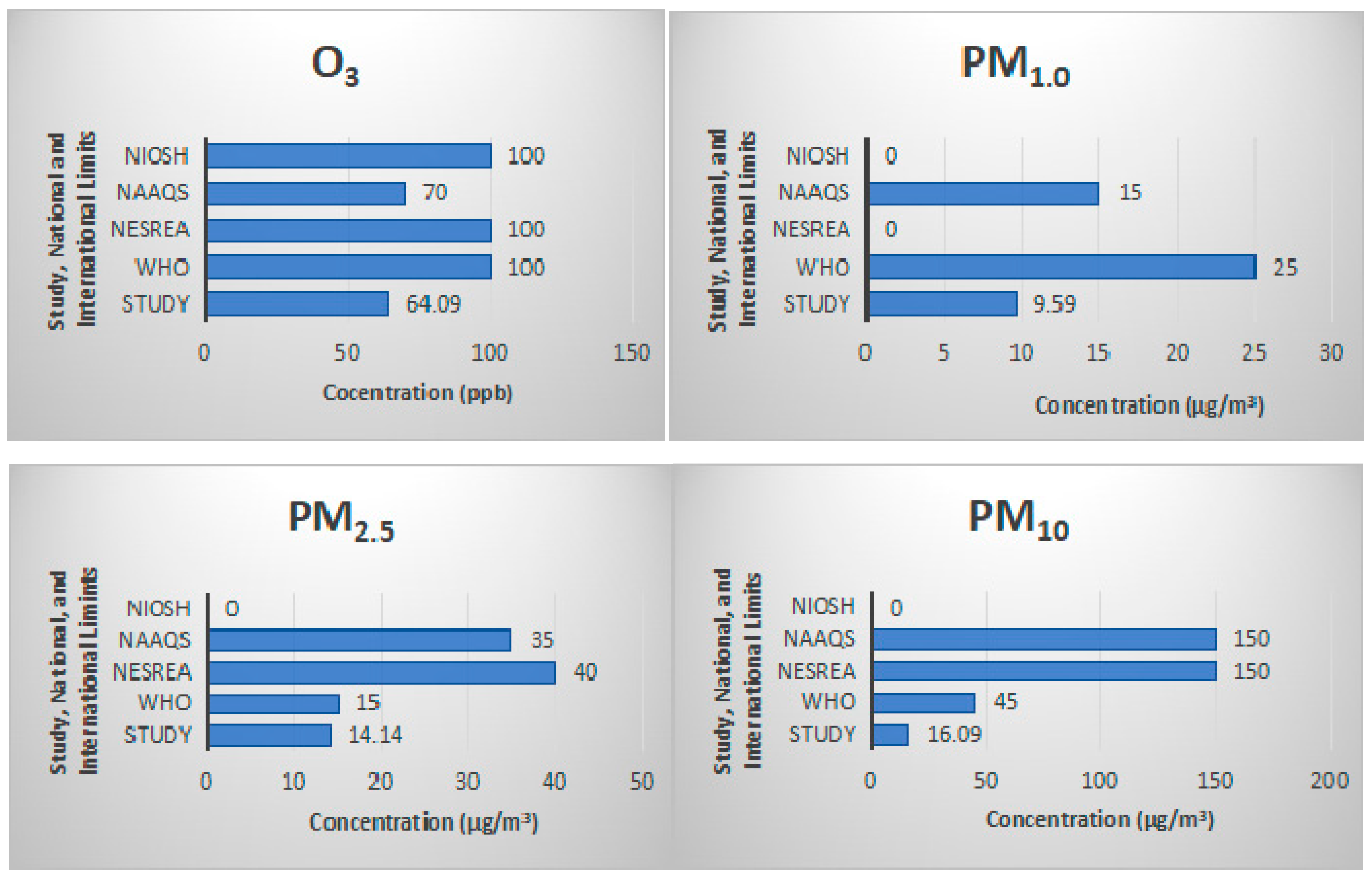Indoor Air Quality Assessment Using a Low-Cost Sensor: A Case Study in Ikere-Ekiti, Nigeria †
Abstract
:1. Introduction
2. Materials and Methods
3. Results and Discussion
4. Conclusions
Author Contributions
Funding
Institutional Review Board Statement
Informed Consent Statement
Data Availability Statement
Acknowledgments
Conflicts of Interest
References
- Abulude, F.O. Right and Cheap Information on Air Quality: The Cases of Real-time Air Quality Index Monitors (Satellite and Phone apps). Acad. Lett. 2021, 2, 3401. [Google Scholar] [CrossRef]
- Schibuola, L.; Tambani, C. Indoor environmental quality classification of school environments by monitoring PM and CO2 concentration levels. Atmos. Pollut. Res. 2020, 11, 332–342. [Google Scholar] [CrossRef]
- Cordell, R.L.; Panchal, R.; Bernard, E.; Gatari, M.; Waiguru, E.; Ng’ang’a, M.; Nyang’aya, J.; Ogot, M.; Wilde, M.J.; Wyche, K.P.; et al. Volatile Organic Compound Composition of Urban Air in Nairobi, Kenya and Lagos, Nigeria. Atmosphere 2021, 12, 1329. [Google Scholar] [CrossRef]
- Feng, Y.; Yang, C.; Cao, X. Intermediate volatile organic compounds in Canadian residential air in winter: Implication to indoor air quality. Chemosphere 2023, 328, 138567. [Google Scholar] [CrossRef] [PubMed]
- Suriano, D. Users Guide Version (v. 1.3) Refers to the SentinAir system Version 1.3 Available at the Github SentinAir Repository. 2021. Available online: https://github.com/domenico-suriano/SentinAir (accessed on 10 October 2022).
- Obisesan, A.; Weli, V.E. Assessment of Air Quality Characteristics across Various Land-Uses in Port-Harcourt Metropolis. J. Environ. Pollut. Manag. 2019, 2, 106. [Google Scholar]
- NIOSH Pocket Guide to Chemical Hazards; U.S. Department of Health and Human Services, Public Health Service, Centers for Disease Control, National Institute for Occupational Safety and Health: Cincinnati, OH, USA, 1994; DHHS (NIOSH) Publication No. 94–116.
- WHO. Global air quality guidelines. In Particulate Matter (PM2.5 and PM10), Ozone, Nitrogen Dioxide, Sulfur Dioxide and Carbon Monoxide; World Health Organization: Geneva, Switzerland, 2021. [Google Scholar]
- Wang, J.; Xie, X.; Fang, C. Temporal and Spatial Distribution Characteristics of Atmospheric Particulate Matter (PM10 and PM2.5) in Changchun and Analysis of Its Influencing Factors. Atmosphere 2019, 10, 651. [Google Scholar] [CrossRef]
- Manisalidis, I.; Stavropoulou, E. Stavropoulos, A.; Bezirtzoglou, E. Environmental and Health Impacts of Air Pollution: A Review. Front. Public Health. 2020, 8, 14. [Google Scholar] [CrossRef] [PubMed]
- NAAQS. Reviewing National Ambient Air Quality Standards (NAAQS): Scientific and Technical Information; US EPA: Washington, DC, USA, 22 May 2023.
- National Environmental Standards and Regulations Enforcement Agency (Establishment) (Amended) Act, 2018; National Environmental (Air Quality Control); Federal Government Printer: Lagos, Nigeria, 2021; pp. B 3364–B 3374.
- Giemsa, E.; Soentgen, J.; Kuschi, T.; Beck, C.; Munkel, C.; Cyrys, J.; Pitz, M. Influence of Local Sources and Meteorological Parameters on the Spatial and Temporal Distribution of Ultrafine Particles in Augsburg, Germany. Front. Environ. Sci. 2021, 8, 609846. [Google Scholar] [CrossRef]


| Parameter | Mean | StDev | CoefVar | Min | Q1 | Q3 | Max | skewness | kurtosis |
|---|---|---|---|---|---|---|---|---|---|
| CO2 (ppm) | 537.48 | 46.91 | 8.73 | 57.60 | 511.67 | 557.50 | 1505.90 | 2.60 | 37.62 |
| NO2 (ppb) | 197.91 | 34.93 | 17.65 | 144.00 | 180.00 | 193.00 | 303.00 | 2.03 | 2.61 |
| O3 (ppb) | 0.16 | 14.72 | 22.96 | 12.00 | 68.00 | 72.00 | 77.00 | −1.55 | 0.83 |
| PM1.0 (µg/m3) | 9.59 | 5.83 | 60.78 | 0.00 | 5.00 | 14.00 | 64.00 | 1.29 | 5.92 |
| PM2.5 (µg/m3) | 14.14 | 8.88 | 62.80 | 0.00 | 8.00 | 20.00 | 124.00 | 1.93 | 11.92 |
| PM10 (µg/m3) | 15.09 | 10.19 | 67.52 | 0.00 | 8.00 | 20.00 | 196.00 | 2.82 | 23.49 |
| Temp (oC) | 32.76 | 1.45 | 4.44 | 23.90 | 31.00 | 33.80 | 35.90 | −0.73 | 2.46 |
| RH (%) | 58.50 | 3.93 | 6.72 | 49.50 | 56.50 | 60.00 | 91.90 | 2.74 | 14.74 |
Disclaimer/Publisher’s Note: The statements, opinions and data contained in all publications are solely those of the individual author(s) and contributor(s) and not of MDPI and/or the editor(s). MDPI and/or the editor(s) disclaim responsibility for any injury to people or property resulting from any ideas, methods, instructions or products referred to in the content. |
© 2023 by the authors. Licensee MDPI, Basel, Switzerland. This article is an open access article distributed under the terms and conditions of the Creative Commons Attribution (CC BY) license (https://creativecommons.org/licenses/by/4.0/).
Share and Cite
Adamu, A.; Arifalo, K.M.; Abulude, F.O. Indoor Air Quality Assessment Using a Low-Cost Sensor: A Case Study in Ikere-Ekiti, Nigeria. Eng. Proc. 2023, 58, 42. https://doi.org/10.3390/ecsa-10-16021
Adamu A, Arifalo KM, Abulude FO. Indoor Air Quality Assessment Using a Low-Cost Sensor: A Case Study in Ikere-Ekiti, Nigeria. Engineering Proceedings. 2023; 58(1):42. https://doi.org/10.3390/ecsa-10-16021
Chicago/Turabian StyleAdamu, Ademola, Kikelomo Mabinuola Arifalo, and Francis Olawale Abulude. 2023. "Indoor Air Quality Assessment Using a Low-Cost Sensor: A Case Study in Ikere-Ekiti, Nigeria" Engineering Proceedings 58, no. 1: 42. https://doi.org/10.3390/ecsa-10-16021






